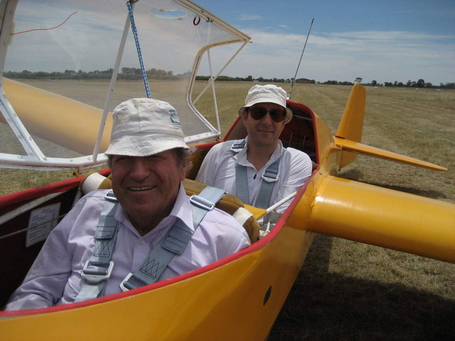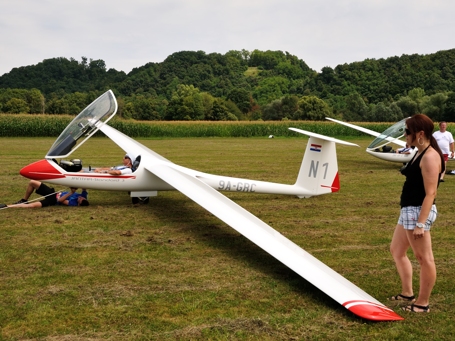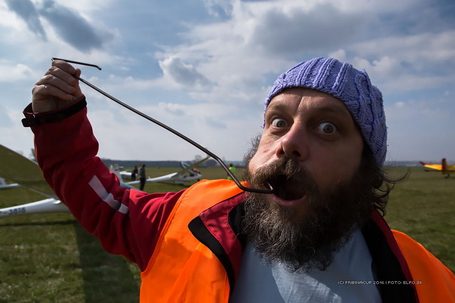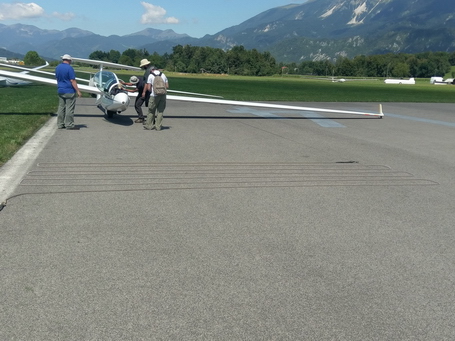



aerokurier Online Contest
OLC-I | Skupno OLC-I
OLC-SI | Skupno OLC-SI
                

                
                





 ostale povezave
ostale povezave
|

Varnost pred vsem – 1. del
(OPENSOARING, 17. avgusta 2016, besedilo Milan Petković-Petko)

Ingo Renner in Milan Petković-Petko v K-7
Pred objavo besedil, ki jih je pripravil Milan Petković-Petko, navdušen jadralec, sicer pa prometni pilot, smo se dogovarjali za prevode. Avtor je menil, da bi zapisi s prevodom izgubili delček svoje natančnosti in tako je pač obveljalo, da besedila ostanejo v izvirniku – torej v angleškem jeziku. Zagotovo jih bomo kdaj kasneje prevedli tudi v slovenščino. Vsekakor pa se avtorju zahvaljujemo, da jih je, posodobljene, ponudil v objavo na Opensoaring.
Spodbuda iz Livna
Last month in Livno Boštjan Pristavec and I had an opportunity to give a brief presentation to the pilot group. Boštjan talked about gliding specifics for Livno and I talked about check list usage in gliding. The pilot group showed a high interest and I was asked by several pilots later on if I had anything in a written form that I could share with them. Their interest and the fact that usage of checklists and procedures improves safety made me decide to send these articles which I have written a few years ago to Opensoaring for publication.
Check Lists and Procedures for Glider Pilots
(written in Hong Kong, August 2014)

If was only after multiple reminders and encouragement from my good friends Karel Čeč, Andrej Kolar and Roman Cvek that I have decided to write this article on the usage of checklists and certain procedures for glider pilots.
Although I have always used checklists and procedures in my professional flying I must admit that it was rather late in my glider flying that I was taught and trained to use them while flying gliders. During my Commercial glider pilot training in the USA I have learned that the official PTS ( Practical Test Standards) issued by the FAA (Federal Aviation Administration) requires every applicant for a pilot rating and exam to demonstrate knowledge and usage of checklists while operating an aircraft and taking an exam. (Similar rules to my knowledge apply to pilots in Australia.) In other words, if during your check ride or exam you do not use the checklists your instructor or examiner might decide not to pass you. These check lists for glider pilots do not have to be in a printed form and used in a “read and do” manner as we use them while flying airline jets but should be used at least in a form of verbal acronyms.
My advice to those of you using check lists for the first time is to have them in a written form somewhere in your cockpit readily available. I have seen pilots with check lists hanging around their neck or microphone on a string. In my glider I had a “Landing Checklist” glued onto my instrument panel so that I could read it easily and hands free.
So let’s get started 

In this article I will cover the following:
1. Positive Control Check
2. Before Take Off Checklist
3. The Rudder Waggle
4. Before Landing Checklist
I have intentionally included and will cover “The positive control check” and “The rudder waggle” due to their extreme importance for safety of flight and due to my observance that not everywhere in the world are these procedures known of and used.
The Positive control check
Just a few facts to get your attention:
1. It is a sad fact that for every written rule in aviation there was at least one accident that preceded it!
2. In many countries glider assembling, positive control checks and critical assembly checks are taught and represent an essential part of the glider pilot training syllabus and manuals!
3. Still way too many accidents have happened with pilots attempting a flight with one or more of their flight controls not connected or incorrectly connected and secured!
For many of us it is a daily routine to assemble the glider at the beginning of a flying day and then disassemble it and stow it back in its trailer at the end of the day. Assembling a glider is not only hard and tiering but also imposes certain risks and safety related functions. With the design of the latest generation of gliders most controls are automatically connected once the wings and the horizontal tail are assembled and secured. With the older gliders having those hard to reach L'hottelier connections the whole process is much more difficult and dangerous. In either case once the glider is completely assembled and equipped to go flying a “Positive Control Check” should be performed.

For this check you as the pilot flying will need an assistant.
Start the check with your assistant holding the left aileron firmly in a full up position. With your control stick now fully deflected to the left try applying reasonable force to move the stick in the opposite direction. As expected you should feel resistance. Now repeat the process with your assistant holding the aileron in a full down position and your stick deflected now to the right. Again, you should feel resistance. If the stick moves freely your controls are not connected correctly!!! Then ask the assistant to let go of the aileron and check for full, free, correct and unobstructed movement of your aileron controls in both directions.
If your glider has flaps the flaps should be checked in a similar manner throughout their full and intermediate range.
Check the speed brakes as well making sure that your assistant's fingers and hands are not trapped and injured during this check!!! The speed brakes should be checked for their full range of motion as well as resistance (while the assistant is holding them). They should also be checked for their ability to lock in their fully closed position.
Next, check the elevator with it being firmly held full down and the stick fully forward. Then elevator full up and the stick fully aft. Then check for full, free, correct and unobstructed movement of your elevator in both directions.
The trimmer should be checked for its full and correct range of motion.
Although not assembled the rudder should also be checked with the help of your assistant in a similar manner for full, free, correct and unobstructed movement while pushing the rudder pedals full left and full right.
Continue checking all flight controls going in a circle around your glider in the same manner that you perform a daily preflight inspection.
In addition to this flight control check you must make sure that all bolts, pins and connections are secure and where they should be. Some gliders have mirrors built in to help you and for others you will need to do your best to see and feel that everything is in a position for safe operation.

Finally if there were any removable panels they should also be put in their slots and secured.
Don’t forget to install pitot and TE probes in their designated receptacles. If there is any possibility of installing them in reverse I strongly advise you to mark them simply by using insulation electrical tape. Then you can just match red on red and white on white and will not miss a fabulous day of flying like I have several years ago in Namibia 
In the USA during contests it is a common practice and requirement to put a marker signature on left wing root tape once the positive control check has been performed. When the glider is in line for take off contest officials will check every and each glider for this signature therefore verifying that the glider is safe for operation following its assembly. If the signature can not be seen you will be denied a take off in the interest of your safety. This procedure makes perfect sense and I strongly recommend it to every glider operation!
In some countries aviation regulations require that you hold an official authorization to assemble gliders and perform daily inspection. If authorized, you will need to make an entry in the aircraft logbook of the daily inspection which you have performed.
Assembly of a glider and its checks is a safety critical function! You should approach it with the same focus and attention as you do when you are getting ready for take off! The newer and fancier your glider is the more curious spectators it will gather. Be aware that they can represent a serious distraction to you! Politely ask them to give you some time and space to complete your glider assembly job and that thereafter you will be able to answer their numerous questions and inquires 
This article was written to the best of my knowledge and experience but in no way does it override or substitute the need and requirements to use your official aircraft manuals, procedures and government publications dealing with your aircraft operation, assembly and its checks. Therefore it is your responsibility to comply with all the procedures in the best interest of safety and the author of this text can not be held responsible in any way or manner.

Safe flying to all of you,
Milan Petković, Petko
                                                  
na vrh strani
                                                  
|

Matt »Balleka« Wright – v spomin
Varnost pred vsem – 4. del
Before Landing check list
Varnost pred vsem – 3. del
The Rudder Waggle
Varnost pred vsem – 2. del
Before Take Off Check List
Nova mladost starega Herkula ali
Prijedor v družbi s Ptujem, Mariborom in Celjem ...
Varnost pred vsem – 1. del
Šolanje jadralnih pilotov 2016 v AK Celje
O Cirrusu d.o.o. malo drugače
Tehnični dan Aerokluba ALC Lesce
Matevž Lenarčič – še tretjič okoli sveta
Sobota z Edom Krištom ter Livno 2016
Dva dneva v Celju – za užitek, izobraževanje in razmislek
Se obetajo letalniku lepši časi?
Svetovni rekord na vitlo – 1852 m
                
Blog 2017
Blog 2016
Blog 2015
Blog 2014
Blog 2013
Blog 2011
Blog 2010
Blog 2009 |

|










